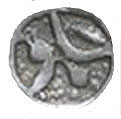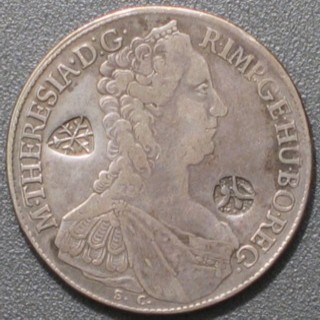
Java is one of the major Indonesian islands.
Research
When Java was part of Netherlands East Indies, the Dutch government oficially applied a round countermark with Arabic "Djawa" (=Java) to milled Dutch ducats (Scholten, Coins of the Dutch Overseas Territories, pg. 60, 61). This countermark was introduced by Resolution of 13 December 1753. By order of the home authorities of the Company the stamping of the Ducats was stopped in accordance with the Resolution of 4 September 1761.In the Fonrobert auction, a half Gold Rider of Overyssel 1760 with countermark "Jawa" is listed as #367. The present whereabouts of this piece is unknown. No official records exist concerning the counterstamping of this type of coin. The genuineness of this stamp is therefore questionable (ref. Scholten., pg. 58).
A similar counterstamp was used to countermark Persian Rupees. A resolution or placard by which this type of countermarkes coins was put into circulation is not known, but in a resolution of Oct. 2, 1758, it is declared that the stamp for the Persian Rupees was no longer in use. In 1760, a decision was made to withdraw all countermarked Batavian, Surat, and Persian Rupees for 30 Stivers apiece and reissue them at a rate of 27 Stivers. From the known authentic specimen it can be seen that they are extremely rare and that they were freshly imported items when they were counterstamped. Date range for the known specimen is approximately 1745-1750.
The "Jawa" countermark is also found on Maria Theresa Thalers and on Mexican Reales.
It is listed as J1 below.
J1 was seen on older (pre-1780) Maria Theresa Talers in a number of coin auctions,
often together with the Madura Star (S1a/b, see below).
It is unlisted in the Hafner catalog.
Specimen
The March 1968 auction of Hans Schulman lists as lot #1430: ' JAVA. Maria Theresa Taler 1780 SF, ctstpd. with round stamp "star"'. This might refer to counterstamp S6 below, to Hafner 106, which is commonly attributed to Ethopia, or to Hafner 132 (Mukalla). Since there is no photo, this is just a wild guess.
Conclusion
The status of Java counterstamps on Maria Theresa Thalers is questionable. There is no known historic reference indicating that the counterstamp was ever officially applied to non-Dutch coins. Also, if the counterstamp was applied in the 19th century or in the late 18th century, one should think that it would have been offered in coin auctions before 1968. However, I have been unable to locate a sale earlier than 1968.Numismatists today believe that the Java counterstamp was applied to Maria Theresa Talers, Real Batoe, and other Talers at a later time to "fulfil collectors' demands".
Acknowledgements
Many thanks to Bernard Olij and Jan Lingen for providing valuable information about Java and Soumenep counterstamps.

